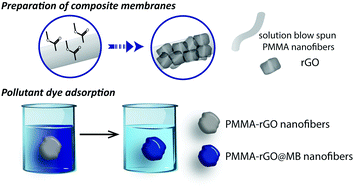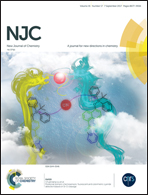Solution blow spun PMMA nanofibers wrapped with reduced graphene oxide as an efficient dye adsorbent†
Abstract
Nanotechnology has provided innovative solutions to guarantee sustainable energy and maintain a clean environment for the future. In this regard, 1D nanostructured materials, such as nanofibers, are very attractive, especially for the development of economic and environmentally friendly approaches for wastewater treatment. Recently, Solution Blow Spinning (SBS) has appeared as a powerful fiber forming technique with several advantages compared to the traditional electrospinning method. Herein, we present the fabrication of composite membranes using solution blow spun poly(methylmethacrylate) nanofibers wrapped with reduced graphene oxide (PMMA-rGO) to adsorb methylene blue (MB), which is a typical dye used in the printing and dyeing industry. The dye adsorption kinetics and isotherm follow the pseudo-second-order and the Langmuir models, respectively. The π–π stacking interactions were considered to be the major driving force for the spontaneous adsorption of MB and the maximum adsorption capacity was 698.51 mg g−1 according to Langmuir fitting. The developed nanocomposite shows great potential for decolorizing dyeing wastewater aimed at industrial and environmental remediation applications.



 Please wait while we load your content...
Please wait while we load your content...